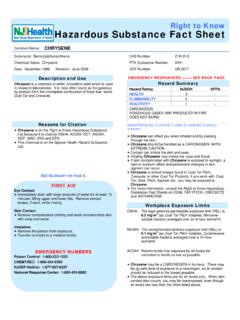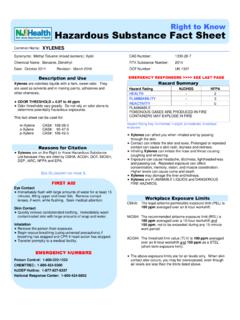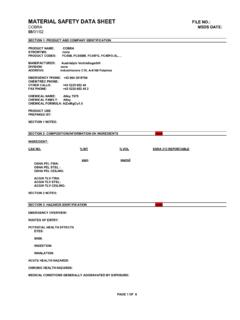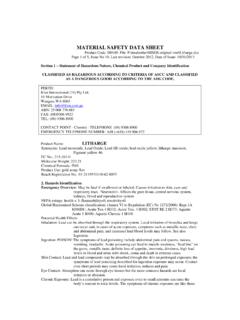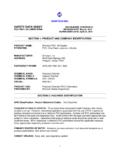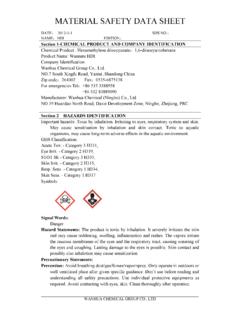Transcription of MATERIAL SAFETY DATA SHEET RED DYE - ..:: Pavco, Inc.
1 MATERIAL SAFETY data SHEET RED DYE June 2013 Page 1 of 6 Prepared according to OSHA, CMA, ANSI, Canadian WHMIS, Australian WorkSafe, Japanese Industrial Standard JIS Z 7250:2000, and European Union REACH Regulations SECTION 1 - PRODUCT AND COMPANY IDENTIFICATION PRODUCT NAME: RED DYE PRODUCT CODE: DY300 CHEMICAL FAMILY NAME: Dry Blend NUMBER: None DANGEROUS GOODS CLASS: Non-Regulated MATERIAL SUPPLIER/MANUFACTURER'S NAME: PAVCO INC ADDRESS: 1935 John Crosland Jr. Dr, Charlotte, NC 28208 USA EMERGENCY PHONE: TOLL-FREE in USA/Canada 1-800-424-9300 Chemtrec BUSINESS PHONE: 1-704-496-6800 (Product Information) BUSINESS FAX: 1-704-496-6810 WEB SITE: DATE OF PREPARATION: June 5, 2013 DATE OF LAST REVISION: October 11, 2007 SECTION 2 - HAZARDS IDENTIFICATION EMERGENCY OVERVIEW: Product Description: This product is a dark red powder with no odor.
2 Health Hazards: Prolonged or repeated exposure to this product may cause skin irritation. Contact with eyes may cause irritation. Inhalation of dust may cause irritation. Ingestion may cause nausea, diarrhea, and gastrointestinal discomfort. Flammability Hazards: This product is a Non-Flammable solid Reactivity Hazards: None known. Environmental Hazards: No data available on this product and its effects on aquatic life. Emergency Considerations: Emergency responders must wear the proper personal protective equipment (and have appropriate fire-suppression equipment) suitable for the situation to which they are responding. US DOT SYMBOLS CANADA (WHMIS) SYMBOLS EUROPEAN and (GHS) Hazard Symbols Non-Regulated Signal Word: Warning!
3 EU LABELING AND CLASSIFICATION: Classification of the substance or mixture according to Regulation (EC) No1272/2008 Annex 1 EC# 231-820-9 This substance is not classified in the Annex I of Directive 67/548/EEC Substances not listed either individually or in group entries must be self classified. GHS Hazard Classification(s): Eye Irritant Category 2 STOT SE Category 3 Skin Irritant Category 3 Hazard Statement(s): Precautionary Statement(s): H313: Causes mild skin irritation H320: Causes eye irritation H333: May be harmful if inhaled P260: Do not breath dust/fume/gas/mist/vapors/spray P264: Wash hands thoroughly after handling. P280: Wear protective gloves/protective clothing/eye protection/face protection EU HAZARD CLASSIFICATION PER DIRECTIVE 1999/45/EC: [Xi] Irritant MATERIAL SAFETY data SHEET RED DYE June 2013 Page 2 of 6 Risk Phrases: R36/37/38: Irritating to eyes, respiratory system and skin SAFETY Phrases: S24/25: Avoid contact with skin and eyes.
4 S26: In case of contact with eyes, rinse immediately with plenty of water and seek medical advice. HEALTH HAZARDS OR RISKS FROM EXPOSURE: ACUTE: EYE CONTACT: Contact may cause eye irritation. SKIN CONTACT: Contact may cause irritation in sensitive individuals. INHALATION HAZARDS: Inhalation of dust may cause respiratory tract irritation. INGESTION HAZARDS: May cause gastrointestinal irritation CHRONIC: None known TARGET ORGANS: ACUTE: Eye, respiratory System, Skin CHRONIC: None known SECTION 3 - COMPOSITION and INFORMATION ON INGREDIENTS HAZARDOUS INGREDIENTS: CAS # EINECS # ICSC # WT % HAZARD CLASSIFICATION; RISK PHRASES Non Hazardous Dry Blend containing Sodium Sulphate 7757-82-6 231-820-9 Not Listed 10 20% HAZARD CLASSIFICATION: [Xi] Irritant RISK PHRASES: R36/37/38 Balance of other ingredients are non-hazardous or hazardous in less than 1% in concentration (or for carcinogens, reproductive toxins, or respiratory sensitizers).
5 NOTE: ALL WHMIS required information is included in appropriate sections based on the ANSI format. This product has been classified in accordance with the hazard criteria of the CPR and the MSDS contains all the information required by the CPR, EU Directives and the Japanese Industrial Standard JIS Z 7250: 2000. SECTION 4 - FIRST-AID MEASURES EYE CONTACT: If product enters the eyes, open eyes while under gentle running water for at least 15 minutes. Seek immediate medical attention if irritation persists. SKIN CONTACT: Wash skin thoroughly after handling. Seek medical attention if irritation develops and persists. Remove contaminated clothing. Launder contaminated clothing before re-use. INHALATION: If breathing becomes difficult, remove victim to fresh air.
6 If necessary, use artificial respiration to support vital functions. Seek medical attention if breathing dificulty continues. INGESTION: If product is swallowed, call physician or poison control center for most current information. If professional advice is not available, do not induce vomiting. Never induce vomiting or give diluents (milk or water) to someone who is unconscious, having convulsions, or who cannot swallow. Seek medical advice. Take a copy of the label and/or MSDS with the victim to the health professional. MEDICAL CONDITIONS AGGRAVATED BY EXPOSURE: Pre-existing skin, or respiratory system problems may be aggravated by exposure to this product. RECOMMENDATIONS TO PHYSICIANS: Treat symptoms and reduce over-exposure.
7 SECTION 5 - FIRE-FIGHTING MEASURES FLASH POINT: Non-Flammable Solid AUTOIGNITION TEMPERATURE: Not Established FLAMMABLE LIMITS (in air by volume, %): Lower (LEL): Not Established Upper (UEL): Not Established FIRE EXTINGUISHING MATERIALS: Use media suitable for surrounding area. Carbon dioxide, foam, dry chemical, halon, water spray. UNUSUAL FIRE AND EXPLOSION HAZARDS: None known Explosion Sensitivity to Mechanical Impact: Not Sensitive. Explosion Sensitivity to Static Discharge: Not Sensitive SPECIAL FIRE-FIGHTING PROCEDURES: Incipient fire responders should wear eye protection. Structural firefighters must wear Self-Contained Breathing Apparatus and full MATERIAL SAFETY data SHEET RED DYE June 2013 Page 3 of 6 protective equipment.
8 Isolate materials not yet involved in the fire and protect personnel. Move containers from fire area if this can be done without risk; otherwise, cool with carefully applied water spray. If possible, prevent runoff water from entering storm drains, bodies of water, or other environmentally sensitive areas. NFPA RATING SYSTEM HMIS RATING SYSTEM HAZARDOUS MATERIAL IDENTIFICATION SYSTEM Flammability HEALTH HAZARD (BLUE) 1 FLAMMABILITY HAZARD (RED) 0 Health Reactivity PHYSICAL HAZARD (YELLOW) 0 PROTECTIVE EQUIPMENT EYES RESPIRATORY HANDS BODY Other See Sect 8 See Sect 8 For Routine Industrial Use and Handling Applications Hazard Scale: 0 = Minimal 1 = Slight 2 = Moderate 3 = Serious 4 = Severe * = Chronic hazard SECTION 6 - ACCIDENTAL RELEASE MEASURES SPILL AND LEAK RESPONSE: Personnel should be trained for spill response operations.
9 SPILLS: SMALL SPILL: Sweep up MATERIAL and transfer to an appropriate container. LARGE SPILL: Dike the area of the spill to prevent spreading. The MATERIAL may then be taken up with vacuum and transferred to appropriate containers. Notify proper authorities if required by local, state, or federal regulations. Dispose of in accordance with applicable Federal, State, and local procedures (see Section 13, Disposal Considerations) SECTION 7 - HANDLING and STORAGE WORK PRACTICES AND HYGIENE PRACTICES: As with all chemicals, avoid getting this product ON YOU or IN YOU. Wash thoroughly after handling this product. Do not eat, drink, smoke, or apply cosmetics while handling this product. Use in a well-ventilated location. Remove contaminated clothing immediately.
10 STORAGE AND HANDLING PRACTICES: Store in a cool, dry location in original container. For storage & usage, it is important to take special notice of the shelf life of this product which is provided on the Cert. of Analysis. SECTION 8 - EXPOSURE CONTROLS - PERSONAL PROTECTION EXPOSURE LIMITS/GUIDELINES: Chemical Name CAS# ACGIH TWA OSHA TWA WEEL Non Hazardous Dry Blend containing Sodium Sulphate 7757-82-6 10 mg/m Total Dust 15 mg/m Total Dust 10 mg/m Total Dust Currently, International exposure limits are not established for the components of this product. Please check with competent authority in each country for the most recent limits in place. VENTILATION AND ENGINEERING CONTROLS: Use with adequate ventilation to ensure exposure levels are maintained below the limits provided above.

